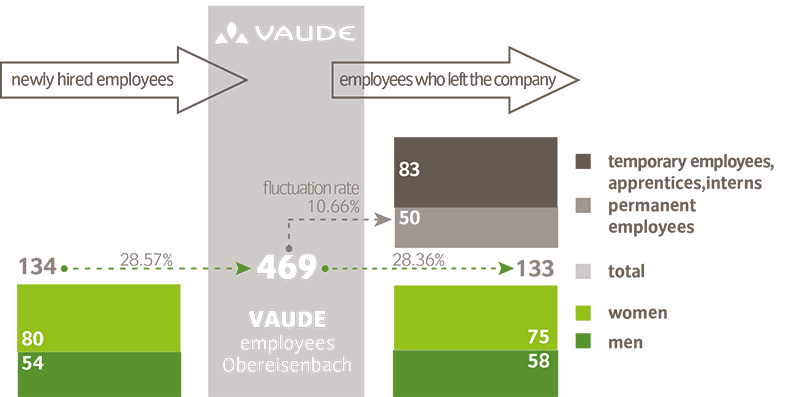
Satisfied employees are motivated
In the Top 10 of "Erfolgsfaktor Familie" (Success Factor Family)
In 2012, we participated in the German-wide business competition “Erfolgsfaktor Familie“ (Success Factor Family) of the Federal Ministry for Family Affairs in order to have our efforts towards good employee policies evaluated by an independent body. Every two to three years, this evaluation honors Germany’s most family friendly companies.
More than 350 companies participated in this competition, in which VAUDE made it to the final round of the ten best companies in the category of mid-sized enterprises (up to 1,000 employees).
Employee survey every two years
In order to obtain valid data on employee satisfaction, we partake in a comprehensive employee survey that is evaluated by an independent institute (NPM Institute for Sustainable Human Resource Management) for a total of nine companies every two years. In the 2013 survey, in five of 23 questions VAUDE was rated as especially good and above average:
| GRI: | LA1 |
| GRI: | DMA Employment |
| GRI: | DMA Labor/ Management Relations |
- knowledge of and identification with the company's objectives
- balancing work and family life - see „"Family Company" in the truest sense of the phrase“
- value placed on the importance of employees enjoying working for the company
- open and trusting climate - see „Culture of value and trust“
- employee motivation
These results confirm our belief that we are on the right track in regards to the significance of purposeful employment. In areas where we did less well, we are taking the results of the employee survey very seriously and analyzing them accordingly. In an ongoing process, we derive measures of action from this evaluation in order to perform better in the future.
Compensation system is being revised
The statement that "our compensation system as a whole is very fair", was our weakest point in the employee survey. In order to counteract this, we have started the project "Introduction of a payroll system" in 2013.
The goal of the project is to introduce a fairer and more performance-based compensation system to reward comparable services with comparable pay. The project will be completed in 2014. The various measures derived therefrom shall be implemented in the coming years.
For example, we have decided to pay a minimum wage starting in early 2014.
SWOT and interface analysis every two years
In alternating years, we carry out a SWOT analysis and an interface across various departments to illuminate those areas in which we still see improvement potential. The results are summarized on the departmental level and suitable measures are devised.
Turnover as a measure of employee satisfaction
Turnover is an important indicator for us, since a high turnover rate can be an expression of employee dissatisfaction.
During the reporting period, 134 new employees were hired, including 80 women and 54 men. This corresponds to a percentage of 28.57 percent of new hires in relation to all employees. Age groups were not differentiated. All employees who signed a new contract during the reporting period were included as new entrants.
The turnover rate in the reporting period was 133 employees, including 75 women and 58 men. 83 of the people who left the company (i.e. 62 percent) did so because their contracts ended (temporary employees and trainees). Employee turnover rate - without temps and trainees - was 10.66 percent; no distinction was made in this calculation between wage earners and salaried positions. The employee turnover rate including temps and trainees was 28.36 percent. Age groups were not differentiated.
Turnover is also due to our young workforce
We are trying to reduce our turnover rate of 10.66 percent. Furthermore, in the future we will distinguish the numbers of salaried positions and wage-earners in order to obtain information about the respective turnover in these separate areas of activity.

|
"Our relatively high turnover rate is because of the young workforce. Young workers are more mobile. " Helmut Norwat, Head of Human Ressource
|
Due to the different activities and employee structures, we suspect that the rate in the overall management is lower than in that of the rest of the company. At this point, we will be working on obtaining a more stable workforce structure over the midterm.
One explanation for the increased rate is that we recorded a relatively high degree of hires and job leavers due to our young workforce or our low average age. Younger workers are more mobile and change jobs more frequently than older colleagues. We will take a good look at other possible reasons, analyze the numbers and their effects, and discuss and implement possible appropriate measures.





